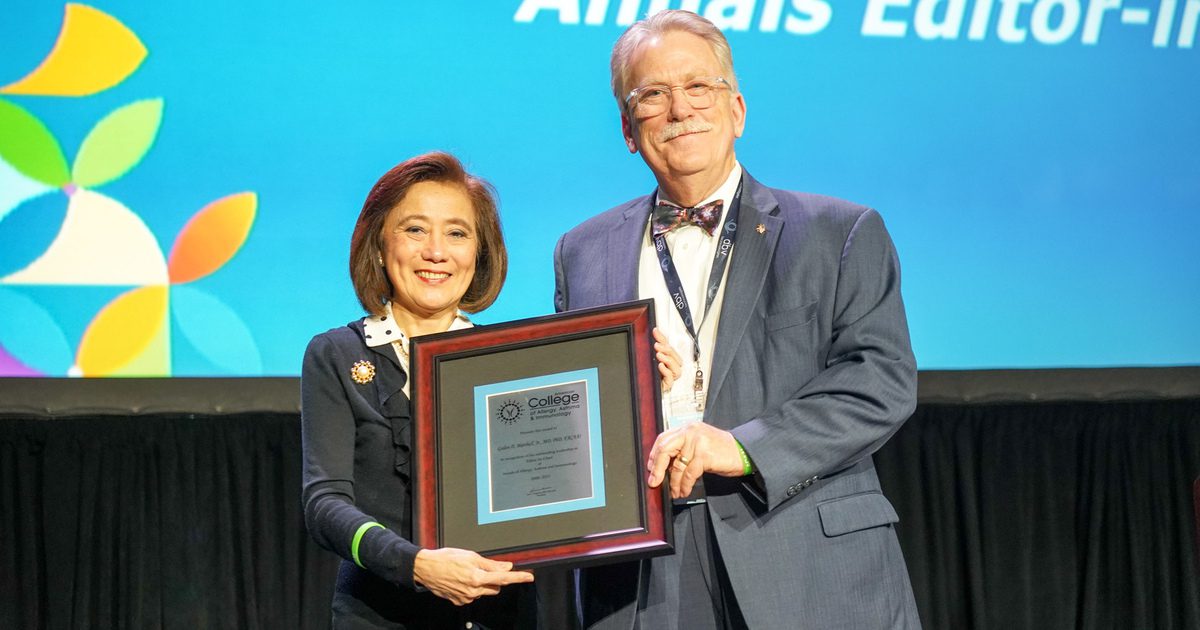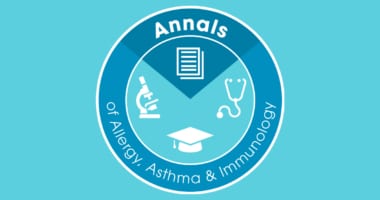It has often been said that all good things must come to an end, and that time has come for me. The December 2021 installment of the Annals of Allergy, Asthma and Immunology marks the 192nd issue whose content I have been privileged to shepherd in my role as editor-in-chief. Pretty much every day for the last 16 years, I have looked online to see what manuscripts have come in for review and how they might ultimately be useful to you, the reader. Like any other, this journey has had its proverbial ups and downs – some days better than others. But as I look back, I am filled with the emotions of gratitude, humility, satisfaction and awe.
I begin with perhaps the most important component of my emotions – gratitude. I distinctly remember a phone call I received from Dr. Michael Blaiss almost 18 years ago when he asked if I would be interested in being considered as a candidate for the next editor-in-chief of the Annals, succeeding the late great Dr. Ed O’Connell. I considered it for a while, then agreed to be a candidate. I was ultimately selected and spent a year apprenticed to Ed, who taught me the things I would need to know to lead the Annals into new areas of success. Ed was an incredible friend and mentor and I am pleased to share my recollections of him through an Annals article. Many younger readers likely never met this giant in our specialty. As I progressed early in my tenure, I began a strong and effective relationship with College staff, led by Rick Slawny. Rick and his team have been incredibly supportive of me personally and our entire Annals operation from day one. There is no way any of this could have been done without them.
I have been blessed with an incredible editorial team. You have seen the multiple executive, deputy and associate editors who have served over the past 16 years. Look at the editorial page in this issue and you will see the “best of the best” in terms of dedicated individuals currently serving the Annals. Look on the same page and you will also see the great list of editorial board members, many of whom have reviewed over 100 manuscripts for the Annals. These colleagues, along with many of you who serve as ad hoc reviewers, provide the essential components to the peer review process. Without your consistent reviews, we have no journal. Thank you so much for your service. We have had two outstanding managing editors during my tenure. Kimberly Stamper was our first managing editor who served with distinction from 2006-2017. It was most fortunate for all of us that Liz Marshall stepped up to assume the managing editor duties initially intended to be an interim replacement. Since Liz is also my wife, I was not really considering her as a permanent replacement until the editors convinced me that she was the perfect person for the job. They were right – she has been an incredible manager and liaison between our publisher, our College staff, the editorial team, the authors, reviewers and readers for the past four plus years. Her staff – Rebecca Marshall (special features editor), Katy James (editorial assistant) and Heather Ney (editorial assistant) have been integral components of an active, effective team that moves manuscripts into and out of the review system and accepted manuscripts into press in an industry leading fashion. I am very grateful for their contributions and professionalism.
The publisher is a critical editorial partner for any journal. When I started in 2006, the Annals was “self published” by the College office with the late Mary Lou Callaghan serving as publisher and liaison between the various components of the journal. In 2010, we began a publishing relationship with Elsevier which has continued for the past 11 years and is a great resource for our journal. Our Elsevier publishing executive, Theresa Monturano, has provided outstanding leadership and support to us in developing many improvements to the publishing process for our journal over the last several years. We are clearly a better journal because of our relationship with Elsevier.
I have great confidence in the continued success of our specialty. It was with that thought in mind that I invited various authors to contribute to this final issue with an emphasis on how our specialty will evolve and change in the years to come. Michael Blaiss, MD, FACAAI, current executive medical director and a past president of the College, provides his perspective on the future direction of the College. This is a particularly important piece for our younger readers to view as you consider how the College can help you and how you can become more involved with the College, as we collectively seek new ways to further our specialty by supporting our practicing clinicians who serve our most important asset – our patients. We all know that reimbursements for our services and procedures are in seemingly unending evolution with new challenges and restrictions becoming ever more present. James Sublett, MD, FACAAI, another past College president and Advocacy Council chair, has provided his extremely informed perspective as to how changing payer reimbursement models will affect our future practices and services that we can offer.
As I contemplated the science and clinical practice topics, I was struck by several thoughts that I hope you find relevant. First, in many areas of the country, allergists-immunologists have become the “go to” experts for the indications and optimal use of biologics for allergic and mast cell mediated diseases. I could think of no more qualified person than Tom Casale, MD, FACAAI, to provide his expertise in a review article that summarizes the current indications and extends the experimental data for future use of biologics in our practices. He addresses the recurrent issues that we all face, such as optimal patient selection, which specific agent to use for which specific patient, assessing clinical effectiveness to warrant continuation and if/when cessation of therapy is indicated.
I was also interested in providing an article that addresses the evolution in our understanding of mast cell diseases that will influence our future practices for diagnosis and management. I reached out to Jonathan Lyons, MD, from the National Institutes of Health, to provide a review of the genetic considerations of mast cell disease as predictor for diagnosis and therapy. He assembled a group of coauthors who form a veritable hall of fame for mast cell clinician scientists. They provided an excellent review of the clinical relevance associated with hereditary differences in tryptase levels using hereditary alpha tryptasemia as the model. This article is particularly relevant for those of us with a limited genetics background and provides paradigms for using genetics to identify disease risk and categorization for treatment strategy development.
As we move into the future, many believe that we will need to expand our patient base to remain viable as a clinical specialty. One thought is that we must increase the size of the “I” in immunologist. A significant frontier for development is better assessment and treatment of secondary immunodeficiency diseases. An outstanding review of the potential for this area was provided by Javier Chinen, MD, PhD, from Baylor College of Medicine. As our technology continues to advance with newer diagnostic techniques and new therapies coming out of the research laboratories into clinical trials, we will have a new category of patients to provide the outstanding clinical care that characterizes our specialty.
I close this rather lengthy tome by briefly describing my other emotions mentioned above. I am humbled by the success that the Annals has achieved over the past 16 years. In recent years, the emphasis of the journal has expanded to the point where our impact factor has improved from 2.316 in 2007 to 6.347 in 2020 (the most current measure). This has been a total team effort and I am humbled that I have been allowed to lead this incredible team.
Finally, I am in awe of future possibilities. Mitchell Grayson, MD, FACAAI, was carefully selected by the College from a number of highly qualified candidates as my successor. He hit the ground running when he started training with me about one year ago. I have seen who he has assembled for his editorial team and also seen a sample of their work, which you will see starting next month. It is incredible in its scope and form. There is much for Mitch and his team to build on, and I am excited to see how they will take the Annals to heights that I have dreamed of. We are in very good hands for the future.
Thank you for your support and loyalty to the Annals in so many different ways. It has truly been the opportunity of a lifetime for me to be involved with this journal. I have been asked to continue in an advisory capacity to preserve an institutional memory perspective and will help where and when I can. No matter what the future holds for any of us as individuals, the Annals of Allergy, Asthma and Immunology, sponsored and supported by the American College of Allergy, Asthma and Immunology, will continue to provide the best possible source of cutting-edge science and clinical information for our primary audience – the practicing allergist-immunologist – to help you as you provide the best possible care for our patients.
I wish all of you the very best in 2022 and beyond.
Gailen D. Marshall, Jr., MD, PhD, FACAAI
Editor-in-chief


